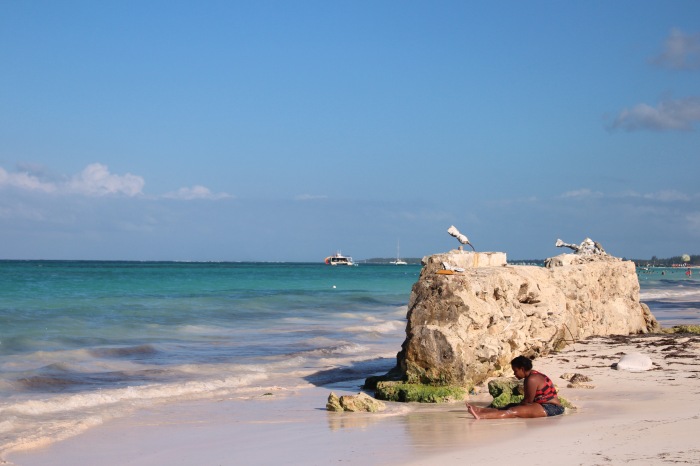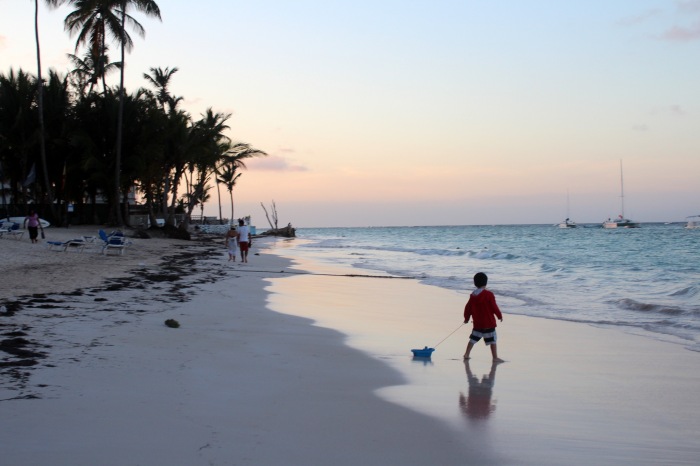MY PARTNER, WHO WE’LL CALL J, and I arrived in Punta Cana in the Dominican Republic four days ago. After we stepped off the plane and got that first hit of humid Caribbean air, I turned to him and said — we are still very fresh. Our clothes are still nicely rolled up in our pack, our skin is still relatively untanned and our Spanish is rough at best. We are still very. very fresh.

J on the beach in Bavaro. This photo was taken as soon as we arrived in Punta Cana, threw our bags on the floor of our room, took our hiking boots off and headed for the beach. Photo: A Bergamin.
To almost prove that point, we boarded our first gua-gua (the Dominican term for a small van that works as a local bus) and the guy-who-collects-the-money-and-knocks-for-the-van-to-stop or conductor, charged us about triple the standard Dominican fare. I have experienced this before catching matatus in Kenya and sometimes, chicken buses in Central America, and mostly it doesn’t bother me. It is pretty much always cheaper to get local transport than a coach or a taxi and despite the often cramped, smelly or hot conditions, nearly always more fun. So we handed over our 500 pesos (about US$12) and figured well, it beats a US$40 cab ride. That was until the lady sitting beside me heard how much we had paid and spent the rest of the trip berating the conductor in very loud and fast Spanish for overcharging us. I think he eventually tired of her and gave us about half the fare back before we hopped off.
It really goes to show that not everybody is necessarily trying to rip you off and most often you will find that people are helpful. More so, in the broader scheme of travel, what does a few more or a few less pesos spent on a local bus, really mean to you anyway?
The gua-gua itself was full and definitely not made to accommodate one very tall American and a big backpack but two buses later, we arrived in Bávaro.
Bávaro was basically built as a tourist center in the easternmost province of the Dominican Republic. It is a place where all inclusive packages rule and after sunset the entire town packs up and returns to the restaurants, bars and casinos within the confines of their resort. My first impression of Bávaro was that it was a city of walls. These walls have been resurrected around huge hotels that hide pristine lawns, golf courses, swimming pools and other ‘entertainment’ for those who stay there. These walls divide up the beach and the land, limit your options of getting around and are an ugly mark on an otherwise very naturally beautiful area.
I imagine that perhaps some day, I may enjoy the easiness of resort holidaying. But for now I feel there is a sort of detachment between the all-inclusive life and the local culture and people that means you are never really experiencing anything fully. At the end of each day we would see many of the resort and restaurant employees sitting in the streets chatting and drinking a Presidente (the Dominican beer) while waiting to catch a gua-gua back into one of the surrounding towns. There are far fewer tourists walking around the streets at this time and the locals waiting by the road seemed relaxed, finally able to enjoy their town. This begs the question, while the security is there to keep the tourists ‘safe,’ who is really keeping who behind walls?
Obviously we did not stay at a five star resort, but at the Bávaro hostel which is a basic but friendly hostel and one of the few in the Dominican Republic. While there are no dinner nights or planned activities that you find at other hostels, the staff is knowledgeable and can answer most questions.
Bávaro’s beaches are certainly beautiful and as this was my first time in the Caribbean I was pretty blown away. The aquamarine water is warm and the sand is white, soft and lined with tall arched palm trees. Bávaro has a fairly international vibe given the many resorts but this also means that Italian supermarkets and French bakeries are as common as the seafood plucked out of the nearby ocean. As vegetarians on a budget it was interesting eating in Bávaro. We came to love a little local place serving a mix of South American, Mexican and American food, called Muchas Gracias and had some great coffee at Dalias cafe (not to mention the many Presidentes and similar, Bohemias, that were drunk on the hostel balcony).
As we spent the first three days of our trip in Bávaro we decided to take it easy and passed our time swimming and lounging around on the beach. If you’re looking to get away from the manicured lawns and resort beach chairs, walk south along the beach until the vegetation almost reaches the water. Very few people walk so far along the sand and although it is unsupervised by lifeguards there is no real danger to speak of, this is the calm Caribbean sea after all. It is here that you’ll find that idyllic postcard beach and you may even spot a few sea stars which was an especially promising sign for an area so trampled by people.
Yesterday we left Bávaro and headed west to another coastal town, Bayahibe, which is nearly the anti-thesis of Bávaro. But more on that next time. Right now, it is dusk, I am drinking a Presidente outside our little cabana and coming from around the corner, outside of the local colmado (small supermarket/town square) there is the roar of merengue and the sound of people chatting. I think it’s time to join the party.
D.I.Y DETAILS
Getting there (Punta Cana airport to Bávaro):
Walk outside of the airport to a main road/highway where there should be a little hut and most likely a few people standing beneath it. We found this was the hardest part so it would be best to ask a few people as you’re leaving to check which direction you want to walk. You’ll then want to catch the Sitrabapu (local bus company) bus to Veron/Cruce de Veron, where there is a large Shell gas station on the corner. From there you catch another bus, also Sitrabapu, to Bávaro. Make sure you have some idea of where you want to get off, a street name or a nearby resort, so that the bus driver can let you know when to get off. It is unlikely they will know smaller hostels and apartments as they are less obvious.
Sleep: Bávaro Hostal
Eat: Try the homemade ciabatta bread from BAM Market (next to Turquesa Resort), it is the best bread you’ll find in the supermarket and excellent to bring on beach picnics.
Drink: Coffee at Dalia’s cafe.
Explore: The south part of the beach beyond the resorts. If you feel like a day away from the ocean, head to one of the surrounding towns such as Higüey, whose large concrete basilica is famous in the Caribbean.
– AB

